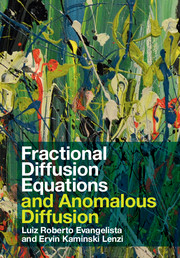Book contents
- Frontmatter
- Dedication
- Contents
- Preface
- 1 Mathematical Preliminaries
- 2 A Survey of Fractional Calculus
- 3 From Normal to Anomalous Diffusion
- 4 Fractional Diffusion Equations
- 5 Fractional Diffusion Equations
- 6 Fractional Nonlinear Diffusion Equations
- 7 Anomalous Diffusion
- 8 Fractional Schrödinger Equations
- 9 Anomalous Diffusion and Impedance Spectroscopy
- 10 The Poisson–Nernst–Planck Anomalous Models
- References
- Index
3 - From Normal to Anomalous Diffusion
Published online by Cambridge University Press: 17 January 2018
- Frontmatter
- Dedication
- Contents
- Preface
- 1 Mathematical Preliminaries
- 2 A Survey of Fractional Calculus
- 3 From Normal to Anomalous Diffusion
- 4 Fractional Diffusion Equations
- 5 Fractional Diffusion Equations
- 6 Fractional Nonlinear Diffusion Equations
- 7 Anomalous Diffusion
- 8 Fractional Schrödinger Equations
- 9 Anomalous Diffusion and Impedance Spectroscopy
- 10 The Poisson–Nernst–Planck Anomalous Models
- References
- Index
Summary
This chapter starts with a brief history of the approaches to diffusion phenomena, by emphasising the first investigations of Brownian motion, i.e., stochastic motion, the random walk problem, and its connection with the diffusion processes. Subsequently, the concepts of anomalous diffusion and continuous-time random walk are introduced. Some formal aspects of the dynamics in normal and anomalous diffusion are presented. The link between these formalisms is established by introducing memory effects in the diffusion processes. In this enlarged scenario, non-Markovian behaviour and temporal memory are incorporated into the description of the diffusive processes in the presence of external fields, thus opening the whole approach to consider the possibility of application of fractional calculus.
Historical Perspectives on Diffusion Problems
The term diffusion comes from the Latin diffusio, diffusionem, connected with the verb diffundere, meaning “to scatter”, “to pour out”, and is formed by dis- “apart, in every direction” plus fundere “pour”. In physics, this term is applied to molecular diffusion, i.e., the random molecular motion by which matter is transported from places of higher to places of lower concentrations.
Pioneering Studies
The pioneering investigations of the diffusion process are usually attributed to the Scottish chemist Thomas Graham (1805–1869), who is also one of the founders of the Chemical Society of London and its first president (1841–1843). An important paper on gaseous diffusion appeared in 1829, in the Quarterly Journal of Science, under the title “A short account of experimental researches on the diffusion of gas through each other, and their separation by mechanical means”. The first lines of the article state [68]:
Fruitful as the miscibility of the gases has been in interesting speculations, the experimental information we possess on the subject amounts to little more than well established fact, that gases of a different nature, when brought into contact, do not arrange themselves according to their density, the heaviest undermost, the lightest uppermost, but they spontaneously diffuse, mutually and equably, through each other, and so remain in an intimate state of mixture for any length of time.
- Type
- Chapter
- Information
- Fractional Diffusion Equations and Anomalous Diffusion , pp. 71 - 100Publisher: Cambridge University PressPrint publication year: 2018



